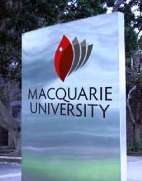Macquarie University Sport and Aquatic Centre
The Macquarie University Sport and Aquatic Centre (MUSAC) is located on the western side of the Macquarie University main campus in Sydney, Australia. MUSAC serves the general public and the university community, providing venues and facilities for 14 university sporting clubs. The centre has also hosted the Sydney Kings basketball team, Sydney FC soccer team, Sydney Swans AFL team, Tennis Australia and the Australian National Swimming Team for training and preparation for international events.[1]
The complex was greatly expanded at a cost of $17 million, opening in July 2007 adjacent to the existing sporting and gymnasium facilities. The expanded complex incorporates environmentally sustainable aspects including rainwater harvesting and strategically located orientation and shading devices, which had it nominated for a Royal Australian Institute of Architects award.[2]
In recent years, the Centre has sought to broaden its appeal by incorporating non-traditional sports, with more emphasis on fun. One of the most bizarre to watch is a land-based version of the fictional game of quidditch, based on the game in the Harry Potter series of children's novels, where the University's "Mac Marauders" have gained media attention.[3]
History
When the University opened in 1964, it included a Sports Association with a one–room gym, two squash courts, and an annual budget of ₤6,000 ($12,000).[4]
Initially known as the "Macquarie University Sports Association" (MUSA), it focussed on the needs of the university community, especially students. This was largely funded by compulsory student fees. This situation changed in 2007 when membership of student organizations became voluntary as part of the Voluntary student unionism legislation. The chief executive of Macquarie University Sport and Recreation at the time, Deidre Anderson, told the Sydney Morning Herald that clubs would need to become self-sufficient.[5]
At this time, MUSA underwent a complete transformation: the old Sports Association organization was dissolved, along with the University Union and other student organizations – the university took direct control and set up a new "Campus Experience" organization as the umbrella for all services.[6] The name "Macquarie University Sport & Aquatic Centre" (MUSAC) was coined for the newly established organization, coinciding with the extensive building programme, which included construction of the two swimming pools.[7] The new centre had an increased focus on catering for the general community, to make up for the funding that previously came from students' compulsory fees.
References
- Antra Kalnins - Editor (9 Apr 2009). "Macquarie Globe edition 15, 2009". Macquarie University - CRICOS provider no. 00002J. Retrieved 2014-04-28.
- "Macquarie University Sports & Aquatic Centre by Cox Richardson Architects". The Royal Australian Institute of Architects. Archived from the original on 19 October 2009. Retrieved 19 May 2014.
- Carey, Alexis (15 April 2014). "From Harry Potter to Sydney schools, Quidditch has become a real competitive sport". Daily Telegraph (Sydney). Retrieved 25 April 2014.
- "Hall of Fame: Australia's first University Sporting Museum". Macquarie University, Sydney Australia. Retrieved 2014-04-28.
- Alexander, Harriet (20 July 2006). "Cheap and flexible - a taste of things to come on campus". Sydney Morning Herald. Retrieved 2014-04-28.
- Hastings, Graham (October 2007). "NUS First Annual Report Into The Impact of Federal VSU Legislation" (PDF). Archived from the original (PDF) on 2013-09-28. Retrieved 2014-04-28.
- "Inductees to Hall of Fame". John Shepherd. Macquarie University, Sydney Australia. 23 October 2009. Retrieved 2014-04-28.
External links
- Official website of Macquarie University Sport and Aquatic Centre
